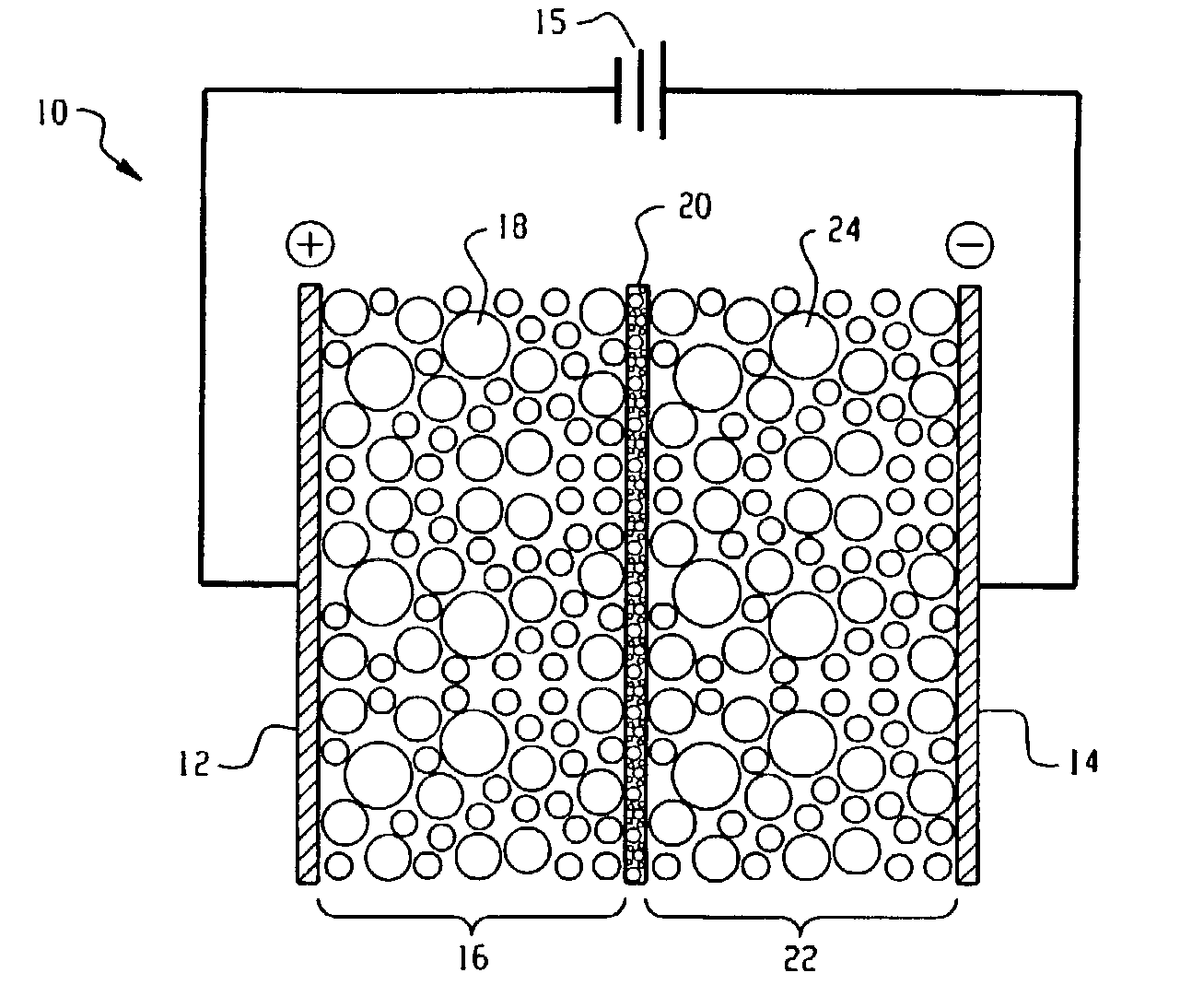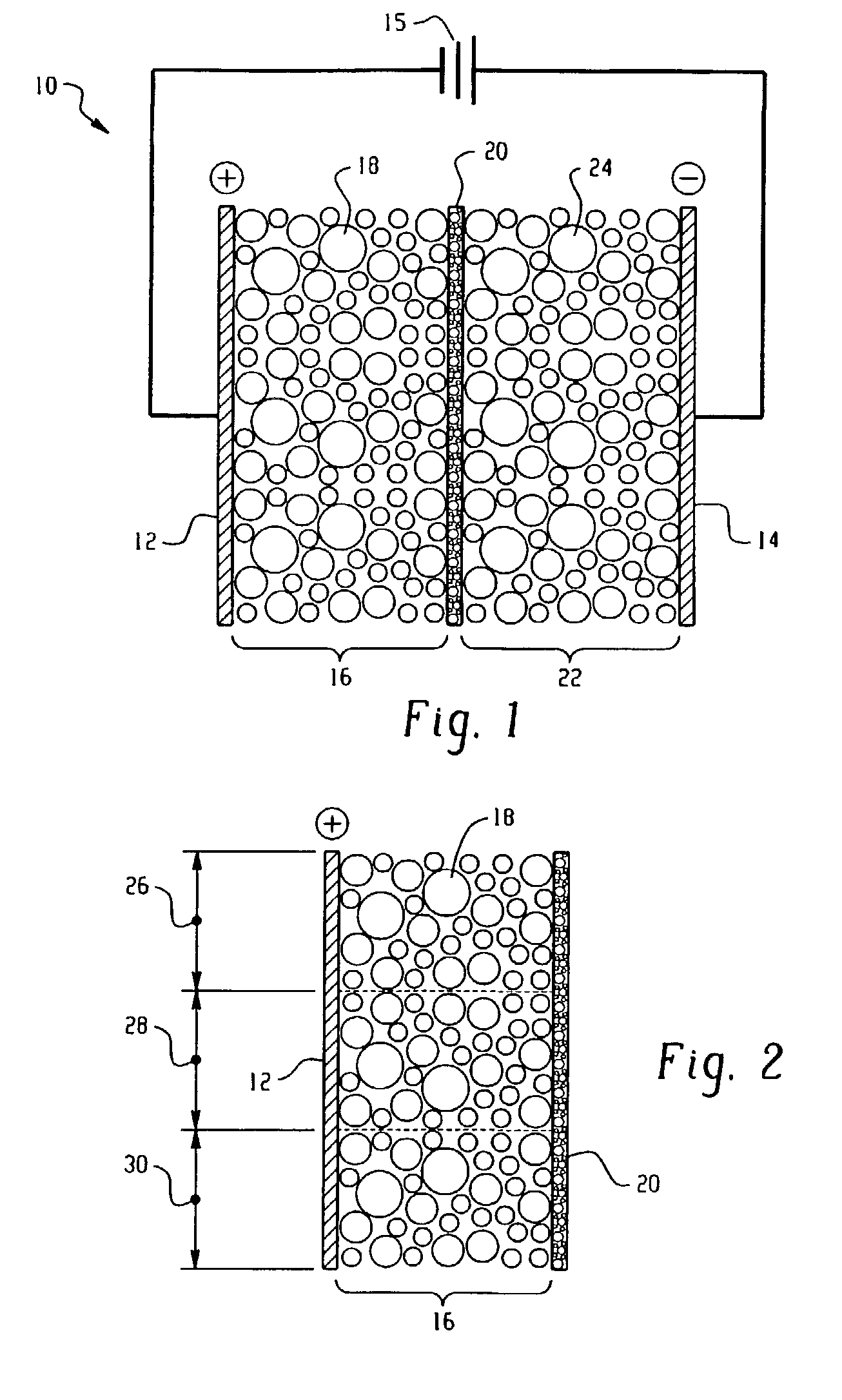Electrolytic process and apparatus
a technology of electrolysis and process, applied in the field of electrolysis, can solve the problems of short shelf life, unstable chlorine dioxide solution, and inability to be commercially available, and achieve the effect of minimizing the diffusion of chlorite ions
- Summary
- Abstract
- Description
- Claims
- Application Information
AI Technical Summary
Benefits of technology
Problems solved by technology
Method used
Image
Examples
example 2
[0077] In this example, a ceramic catalyst material was prepared as follows. A metal oxide precursor solution was prepared by admixing 0.85 grams tetraamineplatinum (II) chloride, 41 ml of 91% isopropyl alcohol, 0.83 ml of 30% ammonium hydroxide and 26 ml of deionized water. The precursor solution was used twice to coat 100 milliliters of SIR-600 resin commercially available from ResinTech, Inc. that had been backwashed and air-dried for about 12 hours. After each coating, the resin was baked at 550.degree. C. for 30 minutes.
example 3
[0078] In this example, electrochemical reactor cassettes were configured as described in FIGS. 4 and 5. The electrode compartments contained SK116 cation exchange resin commercially available from Mitsubishi Chemical. The central compartment contained a particulate material bed of three equal layers. The first layer consisted of SK116 cation exchange resin; the second layer consisted of equal amounts by weight of the SK116 cation exchange resin and the catalyst material; and the third layer consisted of the catalyst material. The catalyst material was prepared in accordance with Examples 1. An overview of the cassette components is shown in Table 1.
1TABLE I Anode DSA, flat sheet Cathode 316L stainless steel, flat sheet Electrode Area 155 cm.sup.2 Membrane Area 155 cm.sup.2 Inter Membrane Spacing 1.27 cm Catalyst Pt impregnated (Example 1) Cation Exchange Resin SK116 (Mitsubishi Chemical) Cation Exchange Membrane CMI-7000 (Membranes International, Inc.)
[0079] Four cassettes containi...
example 4
[0085] In this example, two electrochemical reactor cassettes were configured as described in FIGS. 4 and 5. Each cassette included electrode compartments that contained SK116 cation exchange resin, wherein each compartment was separated from an adjacent compartment by cation exchange membranes (permselective). The central compartment of the first cassette contained a particulate material bed of three equal layers. The first layer consisted of SK116 cation exchange resin; the second layer consisted of equal amounts by weight of the SK116 cation exchange resin and a ceramic catalyst material; and the third layer consisted of the ceramic catalyst material. The ceramic catalyst material was prepared in accordance with Example 1. The central compartment of the second cassette contained a packed bed of Diaion SK1B cation exchange resin. Commercially available from Mitsubishi Chemical, Diaion SK1B is a cross-linked polystyrene cation exchange resin having a cross-linking density of 8%.
[00...
PUM
| Property | Measurement | Unit |
|---|---|---|
| Pore size | aaaaa | aaaaa |
| Pore size | aaaaa | aaaaa |
| Pore size | aaaaa | aaaaa |
Abstract
Description
Claims
Application Information
 Login to View More
Login to View More - R&D
- Intellectual Property
- Life Sciences
- Materials
- Tech Scout
- Unparalleled Data Quality
- Higher Quality Content
- 60% Fewer Hallucinations
Browse by: Latest US Patents, China's latest patents, Technical Efficacy Thesaurus, Application Domain, Technology Topic, Popular Technical Reports.
© 2025 PatSnap. All rights reserved.Legal|Privacy policy|Modern Slavery Act Transparency Statement|Sitemap|About US| Contact US: help@patsnap.com



